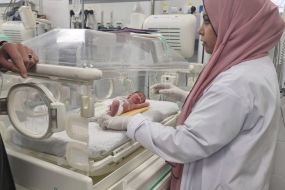The US economy shrank from April through June for a second straight quarter, contracting at a 0.9% annual pace and raising fears that the nation may be approaching a recession.
The decline that the Commerce Department reported on Thursday in the gross domestic product – the broadest gauge of the economy – followed a 1.6% annual drop from January through March.
Consecutive quarters of falling GDP constitute one informal, though not definitive, indicator of a recession.
The GDP report for last quarter pointed to weakness across the economy.
Consumer spending slowed as Americans bought fewer goods. Business investment fell. Inventories tumbled as businesses slowed their restocking of shelves, shedding two percentage points from GDP.
Higher interest rates, a consequence of the US Federal Reserve’s series of rate hikes, clobbered home construction, which shrank at a 14% annual rate. Government spending dropped, too.
The report comes at a critical time. Consumers and businesses have been struggling under the weight of punishing inflation and higher borrowing costs.
On Wednesday, the Fed raised its benchmark interest rate by a sizable three-quarters of a point for a second straight time in its push to conquer the worst inflation outbreak in four decades.
The Fed is hoping to achieve a notoriously difficult “soft landing”: An economic slowdown that manages to rein in rocketing prices without triggering a recession.
Apart from the United States, the global economy as a whole is also struggling with high inflation and weakening growth, especially after Russia’s invasion of Ukraine sent energy and food prices soaring.
Europe, highly dependent on Russian natural gas, appears especially vulnerable to a recession.
In the United States, the inflation surge and fear of a recession have eroded consumer confidence and stirred public anxiety about the economy, which is sending frustratingly mixed signals.
And with the November midterm elections nearing, Americans’ discontent has diminished President Joe Biden’s public approval ratings and increased the likelihood that the Democrats will lose control of the House and Senate.
Watch Chair Powell's statement from the #FOMC press conference:
Intro clip: https://t.co/K2LiY6hWtM
Full video: https://t.co/J8NUrfGgVi
Press Conference materials: https://t.co/D39XU1uopE pic.twitter.com/X1KxuzdgiKAdvertisement— Federal Reserve (@federalreserve) July 27, 2022
Fed chair Jerome Powell and many economists have said that while the economy is showing some weakening, they doubt it is in recession.
Many of them point, in particular, to a still-robust labour market, with 11 million job openings and an uncommonly low 3.6% unemployment rate, to suggest that a recession, if one does occur, is still a ways off.
“The back-to-back contraction of GDP will feed the debate about whether the US is in, or soon headed for, a recession,” said Sal Guatieri, senior economist at BMO Capital Markets.
“The fact that the economy created 2.7 million payrolls in the first half of the year would seem to argue against an official recession call for now.”
Still, Mr Guatieri said, “the economy has quickly lost steam in the face of four-decade high inflation, rapidly rising borrowing costs and a general tightening in financial conditions.”
Thursday’s first of three government estimates of GDP for the April-June quarter marks a drastic weakening from the 5.7% growth the economy achieved last year. That was the fastest calendar-year expansion since 1984, reflecting how vigorously the economy roared back from the brief but brutal pandemic recession of 2020.
But since then, the combination of mounting prices and higher borrowing costs have taken a toll.
Americans are still spending, though more tepidly. Thursday’s report showed that consumer spending rose at a 1% annual pace from April through June, down from 1.8% in the first quarter and 2.5% in the final three months of 2021.
Spending on goods such as appliances and furniture, which had soared while Americans were sheltering at home early in the pandemic, dropped at a 4.4% rate last quarter. Bit spending on services such as airline trips and dinners out rose at a 4.1% rate, indicating that millions of consumers are venturing out more.
Before accounting for surging prices, the economy actually grew at a 7.8% annual pace in the April-June quarter. But inflation wiped out that gain and then some and produced a negative GDP number.
Against that backdrop, Americans are losing confidence. Their assessment of economic conditions six months from now has reached its lowest point since 2013, according to the Conference Board, a research group.
Recession risks have been growing as the Fed’s policymakers have pursued a campaign of rate hikes that will likely extend into 2023.
Even with the economy recording a second straight quarter of negative GDP, many economists do not regard it as constituting a recession.
The definition of recession that is most widely accepted is the one determined by the National Bureau of Economic Research, a group of economists whose Business Cycle Dating Committee defines a recession as “a significant decline in economic activity that is spread across the economy and lasts more than a few months”.
The committee assesses a range of factors before publicly declaring the death of an economic expansion and the birth of a recession — and it often does so well after the fact.
This week, Walmart, the nation’s largest retailer, lowered its profit outlook, saying that higher fuel and food prices were forcing shoppers to spend less on many discretionary items, such as new clothing.
Manufacturing is slowing, too. America’s factories have enjoyed 25 consecutive months of expansion, according to the Institute for Supply Management’s manufacturing index, though supply chain bottlenecks have made it hard for factories to fill orders.
But now, the factory boom is showing signs of strain. The ISM’s index dropped last month to its lowest level in two years. New orders declined. Factory hiring dropped for a second straight month.







